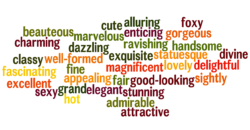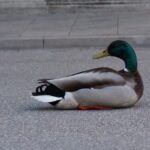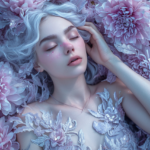
Adjectives are words that describe or modify nouns, pronouns, and sometimes other adjectives.
- That is a beautiful dress! (beautiful describes dress, a noun)
- I am intelligent (intelligent describes the pronoun I)
- Oh, lonesome me (lonesome describes the pronoun me)
- What a bright blue sky! (bright describes the type of blue, also an adjective)
Colors and numbers are often adjectives:
- I have a green pencil.
- I have six pencils.
The articles — a, an, and the — are sometimes their own part of speech, but they are often considered adjectives, since they do come before nouns and modify them.
Some pronouns are also used as adjectives. We talked about the demonstrative and indefinite pronouns in this recent post.
The demonstrative pronouns — of which there are four — can also be used as adjectives. They are then called demonstrative adjectives (this, that, these, those).
- I want this. (pronoun)
- I want this book. (adjective)
- These are pretty. (pronoun)
- These vases are pretty. (adjective)
Some of the indefinite pronouns can also be used as adjectives:
- You can have some. (pronoun)
- You can have some candy. (adjective)
- I have many of those. (pronoun)
- I have many of those toys. (adjective)
Adjectives are pretty simple and have just a few grammar and punctuation issues:
- Comma between adjectives — or not?
- The order of adjectives
- Comparatives and superlatives
Commas between adjectives — or not?
Sometimes you have two (or more) adjectives in front of a noun. Sometimes they both describe the noun. Sometimes the first adjective describes the second adjective.
- It was a cold, snowy night.
- It was a bright blue dress.
In the first example above, both adjectives describe night. And, as you see, there is a comma between the two adjectives. But there is not always a comma between two adjectives that describe the same noun:
- Old plaid shirt
- Big black cat.
How do you know if you should put a comma between two adjectives that describe the same noun? Try putting an and between the adjectives. If it makes sense with the and, you need a comma. Otherwise, there is no comma.
- cold and snowy night makes sense: cold, snowy night
- old and plaid shirt doesn’t really sound right: old plaid shirt
- big and black cat doesn’t really sound right: big black cat.
And if the first adjective describes the second adjective — and not the noun — there is never a comma:
- bright blue sky
- red-and-white striped dress
Order of adjectives
Instead of reinventing the wheel, check out the blog post on this topic!
Five (number) beautiful (quality) tall (size) hundred-year-old (age) bell-shaped green Chinese vases.
Comparative and superlative
Comparatives and superlatives are either adjectives or adverbs. For adjectives we use the -er ending when comparing two things: bigger bicycle. We use -est when comparing three or more things: biggest bicycle in the store. Some adjectives, however, don’t have those -er and -est forms, for example, fun. There is no funner and funnest, although people say those words all the time! For words without -er and -est forms, we use more for comparative and most for superlative: more fun and most fun.
If we are going in the other direction, we use less for comparative and least for superlative: less fun, the least fun of all/ less pretty, the least pretty of all.
Here are the rules: If an adjective has the -er and -est forms, use them. Do not use more and most: prettier (yes), more pretty (no)
Do not use both the -er and more, or the -est and most: more nicer, most nicest (NO)
How do you know if a word has -er and -est forms. Well, you just do. And if you don’t, check with a dictionary.
For the month of September, I would say it it likely I will be running The Best Of The Grammar Diva posts (moving).



My problem is that I was taught that adjectives would allow for an intensifier as premodification (‘I’m very happy’ vs ‘*A very fun time’; and take comparative and superlative forms, which ‘fun’ cannot.
That is why we were told by our professor to speak of ‘noun premodifier’, which could often be so closely associated with the head as to be regarded as compounded with it (and in many cases in relation with a prepositional postmodifier: a time for fun – fun time). This could even lead to ‘real’ noun compounds (bee-sting, earthquake, …) -> funride (?).
Possible I am trying to make some distinction that is not there, but you can understand my problem: after all these years still shrinking from calling a spade a spade — or a noun an adjective, as the case may be.
I actually do not understand your problem…you lost me halfway there. I am not a linguist, and I am sure you are correct. But the distinction makes no real difference in the way we speak or write, so it isn’t within my realm.
I did not know ‘fun’ could be an adjective, but I do know ‘a fun thing’. Is ‘fun’ in that case no longer a substantive? ‘horror-show’: ‘horrorer’? ‘horrorest’?
The ‘rule’ I used to teach to my students about adjectives of more than one syllable was simply:
“Adjectives of two or more syllables take ‘more’ and ‘most’, except those having two syllables ending in ‘-le’, ‘-er’, ‘-ow’, ‘-y’, ‘-some’: nobler-noblest; cleverer-cleverest; narrower-narrowest; happier-happiest, handsomer-handsomest.”
That was it, or at least sufficient….
Thanks for the comment! Fun time? Fun ride? Fun movie? Fun is both a noun and an adjective.